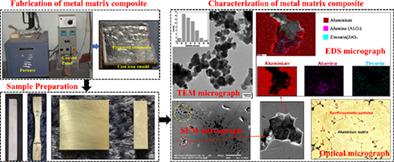当前位置:
X-MOL 学术
›
Polym. Compos.
›
论文详情
Our official English website, www.x-mol.net, welcomes your
feedback! (Note: you will need to create a separate account there.)
Fabrication and mechanical characterization of hybrid composite reinforced with nanoparticles of alumina and zirconia
Polymer Composites ( IF 4.8 ) Pub Date : 2022-06-14 , DOI: 10.1002/pc.26797 Vivek Vij 1 , Raj Agarwal 2 , Mohinder Pal Garg 1 , Rajesh Khanna 3 , Vishal Gupta 2
Polymer Composites ( IF 4.8 ) Pub Date : 2022-06-14 , DOI: 10.1002/pc.26797 Vivek Vij 1 , Raj Agarwal 2 , Mohinder Pal Garg 1 , Rajesh Khanna 3 , Vishal Gupta 2
Affiliation

|
Metal matrix composites are rapidly gaining high attention in the automobile and aerospace industry due to their high performance, lightweight, and great mechanical strength. In this present study, metal matrix composite reinforced with nanoparticles is fabricated using the stir-casting technique. The matrix of the aluminum is reinforced with the nanoparticles of alumina and zirconia in the weight percentage of 6.6% and 3.3%, respectively. For microscopic and mechanical characterization, different specimens were prepared following the standard of fabrication. The microstructural, elemental composition, and distribution along with the interaction of the reinforcement particles with the aluminum matrix are observed using energy-dispersive X-ray (EDX) and scanning electron microscopy (SEM) analysis. The mechanical properties of fabricated nanocomposite are compared with that of the monolithic aluminum metal. The microhardness of the specimen is investigated using a Vickers hardness testing machine. The tensile strength and flexural strength are evaluated using the universal testing machine. It was observed that the reinforcement particles were uniformly and homogeneously distributed in the aluminum matrix. It was witnessed that the mechanical strength was significantly improved during the tensile strength (54.32%) and hardness (114.28%) of the nanocomposite compared to the pure rolled aluminum. However, the flexural strength is reduced by 3.33% with the addition of the reinforcement particles.
中文翻译:

氧化铝和氧化锆纳米粒子增强杂化复合材料的制备和力学性能
金属基复合材料因其高性能、轻量化和高机械强度而迅速在汽车和航空航天工业中获得高度关注。在本研究中,使用搅拌铸造技术制造了用纳米粒子增强的金属基复合材料。铝基体用重量百分比分别为 6.6% 和 3.3% 的氧化铝和氧化锆纳米粒子增强。对于微观和机械表征,按照制造标准制备不同的试样。使用能量色散 X 射线 (EDX) 和扫描电子显微镜 (SEM) 分析观察微观结构、元素组成和分布以及增强颗粒与铝基体的相互作用。将制备的纳米复合材料的机械性能与单片铝金属的机械性能进行了比较。使用维氏硬度试验机研究试样的显微硬度。使用万能试验机评价拉伸强度和弯曲强度。观察到增强颗粒均匀且均匀地分布在铝基体中。可以看出,与纯轧制铝相比,纳米复合材料的机械强度在拉伸强度(54.32%)和硬度(114.28%)期间显着提高。然而,加入增强颗粒后,抗弯强度降低了 3.33%。使用万能试验机评价拉伸强度和弯曲强度。观察到增强颗粒均匀且均匀地分布在铝基体中。可以看出,与纯轧制铝相比,纳米复合材料的机械强度在拉伸强度(54.32%)和硬度(114.28%)期间显着提高。然而,加入增强颗粒后,抗弯强度降低了 3.33%。使用万能试验机评价拉伸强度和弯曲强度。观察到增强颗粒均匀且均匀地分布在铝基体中。可以看出,与纯轧制铝相比,纳米复合材料的机械强度在拉伸强度(54.32%)和硬度(114.28%)期间显着提高。然而,加入增强颗粒后,抗弯强度降低了 3.33%。28%) 的纳米复合材料与纯轧制铝相比。然而,加入增强颗粒后,抗弯强度降低了 3.33%。28%) 的纳米复合材料与纯轧制铝相比。然而,加入增强颗粒后,抗弯强度降低了 3.33%。
更新日期:2022-06-14
中文翻译:

氧化铝和氧化锆纳米粒子增强杂化复合材料的制备和力学性能
金属基复合材料因其高性能、轻量化和高机械强度而迅速在汽车和航空航天工业中获得高度关注。在本研究中,使用搅拌铸造技术制造了用纳米粒子增强的金属基复合材料。铝基体用重量百分比分别为 6.6% 和 3.3% 的氧化铝和氧化锆纳米粒子增强。对于微观和机械表征,按照制造标准制备不同的试样。使用能量色散 X 射线 (EDX) 和扫描电子显微镜 (SEM) 分析观察微观结构、元素组成和分布以及增强颗粒与铝基体的相互作用。将制备的纳米复合材料的机械性能与单片铝金属的机械性能进行了比较。使用维氏硬度试验机研究试样的显微硬度。使用万能试验机评价拉伸强度和弯曲强度。观察到增强颗粒均匀且均匀地分布在铝基体中。可以看出,与纯轧制铝相比,纳米复合材料的机械强度在拉伸强度(54.32%)和硬度(114.28%)期间显着提高。然而,加入增强颗粒后,抗弯强度降低了 3.33%。使用万能试验机评价拉伸强度和弯曲强度。观察到增强颗粒均匀且均匀地分布在铝基体中。可以看出,与纯轧制铝相比,纳米复合材料的机械强度在拉伸强度(54.32%)和硬度(114.28%)期间显着提高。然而,加入增强颗粒后,抗弯强度降低了 3.33%。使用万能试验机评价拉伸强度和弯曲强度。观察到增强颗粒均匀且均匀地分布在铝基体中。可以看出,与纯轧制铝相比,纳米复合材料的机械强度在拉伸强度(54.32%)和硬度(114.28%)期间显着提高。然而,加入增强颗粒后,抗弯强度降低了 3.33%。28%) 的纳米复合材料与纯轧制铝相比。然而,加入增强颗粒后,抗弯强度降低了 3.33%。28%) 的纳米复合材料与纯轧制铝相比。然而,加入增强颗粒后,抗弯强度降低了 3.33%。











































 京公网安备 11010802027423号
京公网安备 11010802027423号